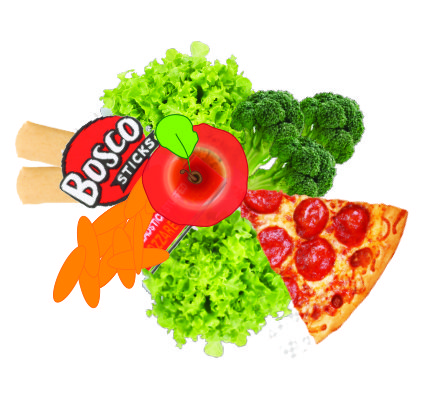More than meets the eye: examining nutrition at ETHS

Graphics designed by Nora Miller
December 13, 2019
Introduction
Periods 4, 5, and 6 at ETHS serve as a time to relax and refuel for several students. However, beyond the rows of tables and chairs lining North, East, West and South cafeterias is a unique arrangement of services nourishing the Evanston Township community. In comparison to lunchrooms at neighboring schools occupying the Northshore, Evanston’s distinctive nutritional lunch, breakfast, and afterschool programs are created from scratch, specifically catering to student health and development.
“The overarching goal is to get the students to eat with us,” explains Assistant Director of Nutrition Services Kelly Diaz.
Resources ETHS has available
Behind trays of warm Bosco sticks and colorful veggies served in each of ETHS’ four cafeterias is the implementation of a specialized menu crafted by Director and Assistant Director of Nutrition Services, Kim Minestra and Kelly Diaz.
Minestra and Diaz employ quantitative data collected on what students purchase daily in the lunchroom to design the ETHS menu. Unlike Chicago Public Schools or the surrounding Northshore suburbs who typically utilize management companies that pre plan meals for the entire school, Evanston’s tailored menus are created independently. One limitation for Nutrition Services is that the department is required to abide by Illinois state programs and regulations provided by the National School Lunch, Breakfast and Afterschool Programs, administered by the United States Department of Agriculture (USDA). The USDA’s requirements for each program can be found on their website, but they include requirements such as required cups of vegetables, fruit, grains, and fat served in cafeterias. The linkage of ETHS’s Nutrition Services department allows Minestra and Diaz to capture what students put on their plates and to specialize their menus. Additionally, the Nutrition Services department attends national and regional conferences to innovate meals for their respective programs.
“When we compare [ourselves] to other schools in northern Illinois, we use a lot of the same products;, we share a lot of ideas with each other,” explains Minestra.
The only three3 year old, newly renovated Edible Acre program has provided Nutrition Services with yet another asset for Evanston, sourcing fresh produce for students. Fresh fruits and vegetables grown on the Edible Acre make up about 3000 pounds of produce throughout the year, according to Minestra. Between the two gardens, which function during the fall and spring months, and the recently remodeled greenhouse, which functions all year round, ETHS’ produce produces meals and vegetable supplements.
Similar to observation of student participation in lunchrooms, the Nutrition Services department also observes usage of the Meal Viewer website and mobile app. Not only does the online menu and the Meal Viewer app display options served in ETHS cafeterias, but they allow students, parents and staff alike to view components of each meal item such as caloric, fat and sugar content. The application and website provide accessible technology,
“We have such a hard time. We can see the analytics of the app and menu website, and it’s so low. It’s one of the things we struggle with,” explains Diaz. “Do students know before they walk into the cafeteria what is being served? And they could. It’s a tool that I think is underutilized.”
Nutrition Services must consider components that other schools with management companies do not. Accounting for all food sold individually, Minestra and Diaz must track individual items daily and balance the amount of more expensive items with cheaper products.
Students may be curious how pricing is decided for each entree or supplementary item during lunch or breakfast. From a food cost standpoint, items which are less accessible for the department are higher in cost. For example, Mongolian beef and a chicken caesar salad entree would be closer in cost than pizza paired with either of the two. Mongolian beef and chicken ceasar salad are less accessible and more expensive than pizza paired with either item since pizza is more accessible and cheaper.
“As long as we’re averaging, we are going to have higher cost items and lower cost items to average into a cost that is feasible for us. We aren’t staying away from items because they cost more,” explains Diaz.
Another caveat expressed by the department and students alike is the lack of staffing throughout cafeterias. Senior Ulo Fretias consistently has bought lunch for his entire high school career, is satisfied with
“I feel like the food is pretty good, especially for being a public high school, but there are definitely sometimes when I spend the majority of my lunch period waiting in line,” explains Fretias.
Breakfast/After school programs
Beginning the school day with a nutrient dense meal improves focus and academic achievement in young adults according to Diaz and the USDA. Items include bagels, smoothies, cereal and milk, oatmeal, hot breakfast sandwiches and occasionally pancakes, donuts and waffles.
“I get it [breakfast] at least three times a week. Typically, I almost always get a bagel,” explains Fretias, “On the days when I don’t have breakfast, it makes the morning feel longer. It’s a long period to go without eating, and it definitely hurts my focus.”
As Nutrition Services continue to cater students’ nutrition as they leave school for the day, they serve about 175 students daily according to the department. Free after-school programs provide students with snacks such as apples, cereal, carrots and bagels. With a hot option in West cafeteria and a more snack-like option at Entrance 2, Minestra explains the free after school snack program intends to engage students on their way home or before extracurricular activities.
“We’re about 43 percent Free and Reduced that would really appreciate a meal at the end of the day,” explains Minestra.
Student Perspectives from students who bring or buy lunch at ETHS
From students who bring lunches to students who purchase meals everyday, every student’s relationship with nutrition at ETHS varies. On one hand, students like junior Josie Hansen find that bringing a lunch supplies her with energy for learning throughout the school day. On the other hand, students who consume lunch and breakfast such as Freties look to ETHS nutrition services for sustainable convenience.
“Not even getting enough, but getting the right nutrients, because if all you get is cookies, it’s just a whole bunch of sugar. I’ve watched people buy a solid 8 cookies from the lunchroom,” explains junior Josie Hansen.
Conclusion
Misunderstood yet available, dining with Evanston is available for all students to utilize on a daily basis. Evanston’s nutrition services program an abundance of opportunities, providing students with early exposure to thoughtfulness to nourishment.
“I think that, especially during school, when you’re not full, and you’re hungry throughout the day, it’s really hard to focus during class and be present,” explains Hansen.









